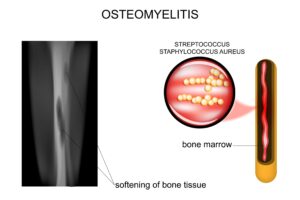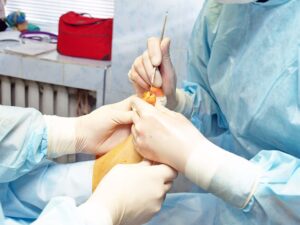 Osteomyelitis is a serious bone infection that can occur due to bacterial or fungal invasion. It is a condition that can cause significant damage to the bone and surrounding tissue and have long-lasting effects if left untreated. In some cases, it can even lead to chronic bone infections, bone death, or amputation. Fortunately, with the help of wound specialists and adhering to proper wound care techniques, Osteomyelitis can be effectively treated, and making a full recovery is possible.
Osteomyelitis is a serious bone infection that can occur due to bacterial or fungal invasion. It is a condition that can cause significant damage to the bone and surrounding tissue and have long-lasting effects if left untreated. In some cases, it can even lead to chronic bone infections, bone death, or amputation. Fortunately, with the help of wound specialists and adhering to proper wound care techniques, Osteomyelitis can be effectively treated, and making a full recovery is possible.
Throughout this guide, we will offer a better understanding of what osteomyelitis is and what causes it, how the condition is diagnosed, and why early intervention and treatment is so important.
What is Osteomyelitis?
Osteomyelitis is an infection of the bone, usually caused by bacteria, fungi, or other pathogens. While infection can start in the bone itself after an injury, in other cases infections reach the bone by spreading from surrounding tissue or through the bloodstream. Osteomyelitis can occur in any bone in the body but is most commonly found in the long bones of the arms and legs, as well as the spine and pelvis.
What Causes Osteomyelitis?
 Osteomyelitis is usually caused when bacteria from infected tissue or an open wound settle in the bone and begin to multiply. The most common bacteria that can result in osteomyelitis are Staphylococcus aureus, which is found on the skin and in the nose, and Pseudomonas aeruginosa. In some cases, osteomyelitis can be caused by an injury or trauma to the bone, which allows bacteria to enter and cause an infection. It can also be caused by a pre-existing infection in the body that spreads to the bone.
Osteomyelitis is usually caused when bacteria from infected tissue or an open wound settle in the bone and begin to multiply. The most common bacteria that can result in osteomyelitis are Staphylococcus aureus, which is found on the skin and in the nose, and Pseudomonas aeruginosa. In some cases, osteomyelitis can be caused by an injury or trauma to the bone, which allows bacteria to enter and cause an infection. It can also be caused by a pre-existing infection in the body that spreads to the bone.
Symptoms of Osteomyelitis
Symptoms of osteomyelitis can vary depending on the type and severity of the infection. In fact, in some cases, osteomyelitis can present no symptoms at all. That said, some of the more common symptoms can include:
- Fever
- Nausea and vomiting
- Swelling and redness around the affected area
- Pain and tenderness in the affected bone
- Limited movement or stiffness in the affected joint
- Drainage from the affected area
- Stiff back or lower back pain (if vertebrae are affected)
If you are experiencing any of these symptoms, it is essential to visit a wound care center as soon as possible.
How is Osteomyelitis Diagnosed?
 Because the symptoms of Osteomyelitis can be similar to other conditions, it can be difficult to diagnose. Your wound specialist will likely begin the process by taking a detailed medical history and performing a physical examination. They may utilize a variety of tests and procedures, including blood tests, imaging tests, and in some cases, bone biopsies.
Because the symptoms of Osteomyelitis can be similar to other conditions, it can be difficult to diagnose. Your wound specialist will likely begin the process by taking a detailed medical history and performing a physical examination. They may utilize a variety of tests and procedures, including blood tests, imaging tests, and in some cases, bone biopsies.
Blood tests can help detect inflammation and signs of infection, and while they might not be able to determine definitively if you have Osteomyelitis, they can help your specialist determine what follow up tests might be needed. Imaging tests are utilized to help identify the location and severity of the infection. A bone biopsy can help in determining what type of infection you have, which can help in identifying the correct course of treatment.
Risk Factors for Osteomyelitis
While young children younger, the elderly, and people with certain circulatory conditions are at a higher risk of developing osteomyelitis other factors may include:
- Compromised Immune System: People with weakened immune systems are at higher risk for developing osteomyelitis.
- Diabetes: People with diabetes are more prone to infections, including osteomyelitis. Osteomyelitis may also develop if you have a foot ulcer.
- Intravenous Drug Use: Drug users who inject drugs intravenously have an increased risk of developing osteomyelitis, as the bacteria can enter the bloodstream through contaminated needles.
- Recent Surgery: People who have recently had surgery or medical procedures that involve the bone or surrounding tissue are also at higher risk.
- Deep puncture wounds or bone fractures: These types of injuries can open a pathway to infection.
Types of Osteomyelitis
There are two main types of osteomyelitis: acute and chronic. Acute osteomyelitis is a sudden and severe infection, while chronic osteomyelitis is a long-term and persistent infection that can last for months or even years.
Treatment for Osteomyelitis
 The treatment of osteomyelitis typically involves a combination of antibiotics and surgery. Antibiotics are used to eliminate the infection, while surgery may be necessary to remove any dead or infected bone tissue.
The treatment of osteomyelitis typically involves a combination of antibiotics and surgery. Antibiotics are used to eliminate the infection, while surgery may be necessary to remove any dead or infected bone tissue.
The type of antibiotics used will depend on the severity of the infection and the type of bacteria or fungus causing it. Surgery may be necessary to remove any dead or infected bone tissue, as well as to help improve blood flow to the affected area. In some cases, bone grafts may also be necessary to help the bone heal.
In addition to antibiotics and surgery, it is important to practice proper wound care and management to prevent the infection from spreading. This can include keeping the affected area clean and dry, changing dressings regularly, and avoiding any activities that could cause further injury. Your wound care specialist can outline a plan and recommendations for you to follow as you heal.
Additionally, it can be important to follow your specialist’s recommendations for treating any underlying conditions that could impair healing such as diabetes.
Specialized Wound Care and Treatment
Osteomyelitis is a serious condition that requires prompt treatment. If you suspect you may have osteomyelitis or are experiencing symptoms, it’s imperative to seek help from a nearby wound care center. The sooner the condition is diagnosed and treated, the better the outcome and the faster you can get back to normal activity.
The specialized wound care physicians at West Coast Wound Center are equipped with the expertise in treating a complete range of wound types and skin concerns including Osteomyelitis as well as other chronic wounds. Reach out to our expert team and let us help put you on the path to healing and back to the quality of life you deserve.
